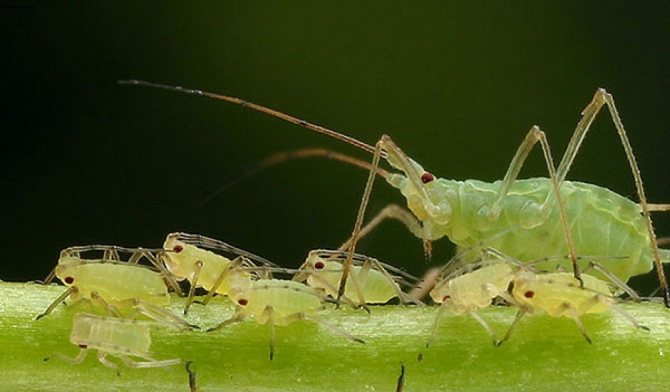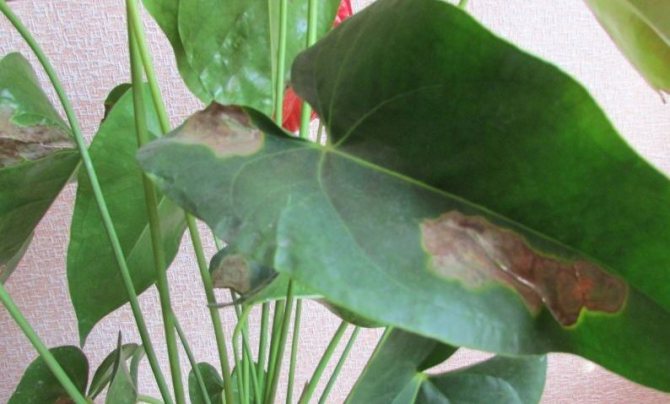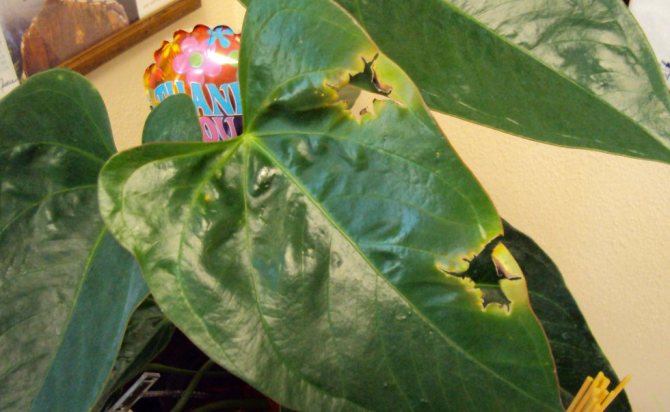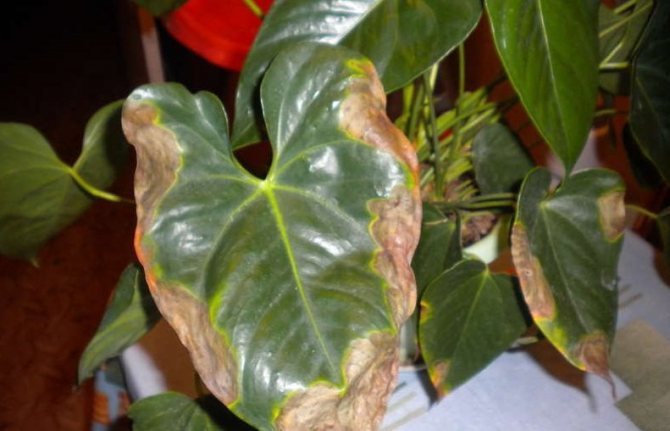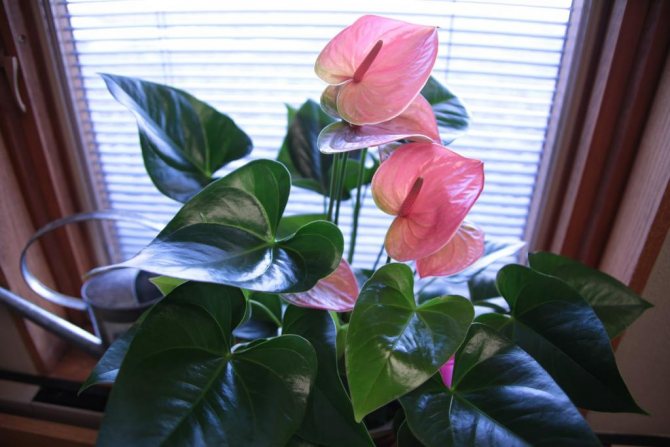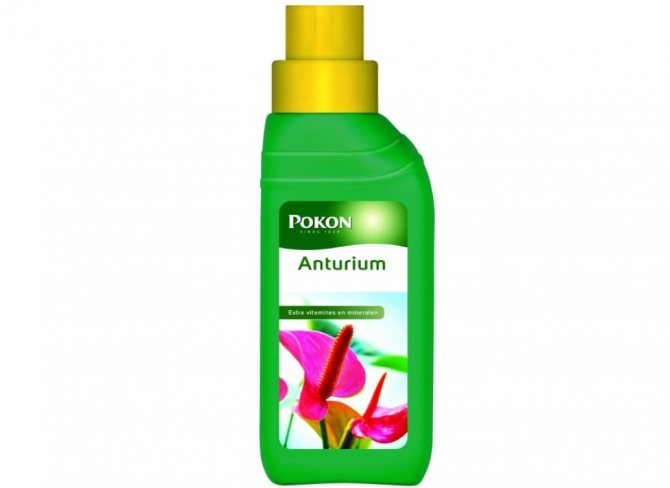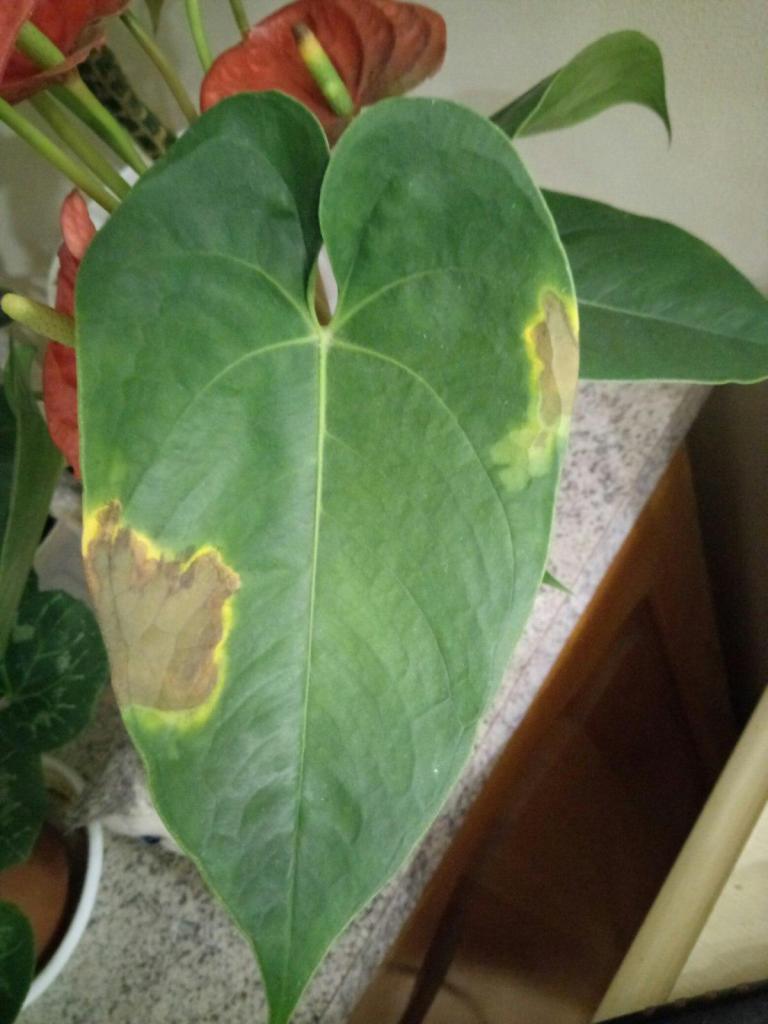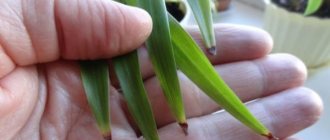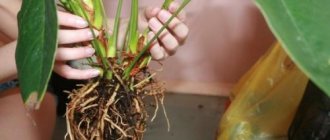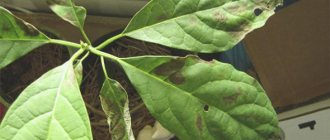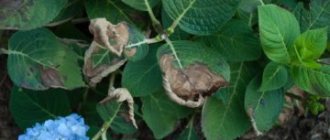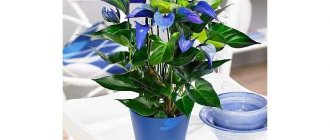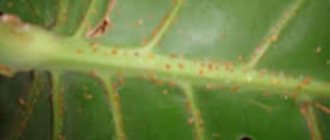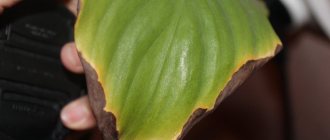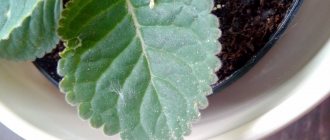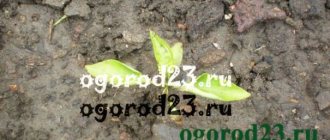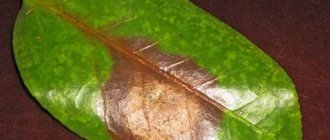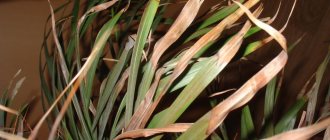This bright exotic flower came to us from South America. From the ancient Greek language, the name Anthurium is translated as "tail" and "flower". The plant belongs to the Aroid family. The color of flowers can be very diverse, and flowering lasts all year round and depends on the lighting. The flowers have such an unusual shape and glossy surface that they have become indispensable for florists when creating compositions.
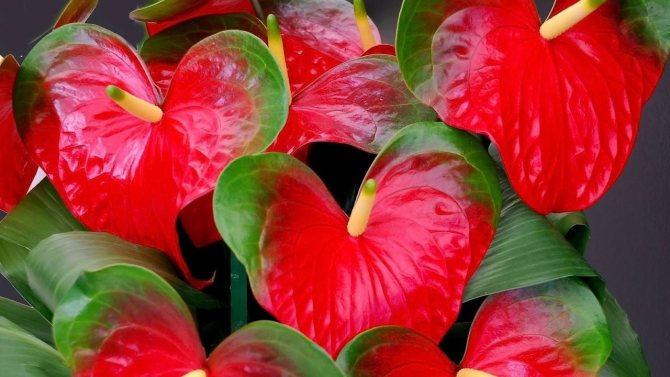
Anthurium
A cut flower can stand in water for up to a month without losing its qualities. Since it is a native of the tropics, there are certain care requirements that are very important for this species - temperature, lighting and humidity. Failure to comply with the rules affects the beauty of the leaf plate. In order for anthurium to please with its flowering, as in the photo, it is important to determine in time the cause of the change in the appearance of the leaves in order to determine how to properly treat and prevent more serious diseases in time.
Why do anthurium leaves and flowers turn black, turn yellow and dry
Anthurium can hardly be called a very capricious plant. He is shade-tolerant and can adapt to being kept in an apartment. It earned great popularity in home floriculture due to its decorative appearance. Bright large green leaves during flowering frame a large glossy flower.
But a fairly common problem when growing is that the leaves and flowers of Man's happiness turn black and dry for no apparent reason. The flower quickly loses its decorative effect and can die if you do not help it in time. A flower can get sick both from improper care and from infection with fungus, bacteria or pests. Depending on the cause of wilting, treatment is selected.
Leaf diseases due to improper care
Blackening and wilting of the plant can be associated with such non-infectious factors:
- Failure to comply with the temperature regime. In winter, the thermometer should not drop below 16 ° C. During the period of active growth and flowering, the temperature should be maintained within 20-25 ° C. If the flower is cold, then black dots will form on the leaf plate, which will begin to rapidly increase in size.
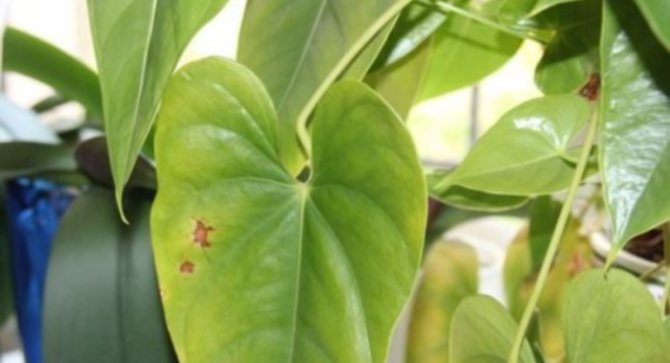

Stains due to non-compliance with the temperature regime - Direct sunlight. Anthurium is photophilous, but prefers diffused light. Under the influence of the bright sun, especially in the summer, it may burn the leaves, which will manifest itself as dry darkened spots and a general weakening of the plant.
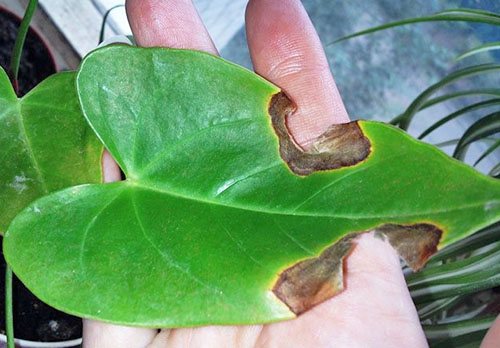

Burns - Watering with hard water. For irrigation, use soft, filtered water at room temperature.
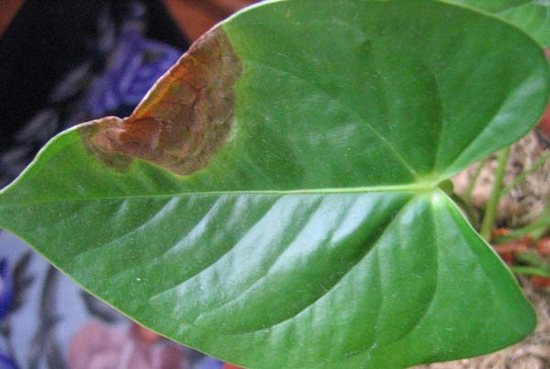

Watering with hard water - Drafts. The flow of cold air is hardly tolerated by a heat-loving plant, which immediately manifests itself on the leaf.
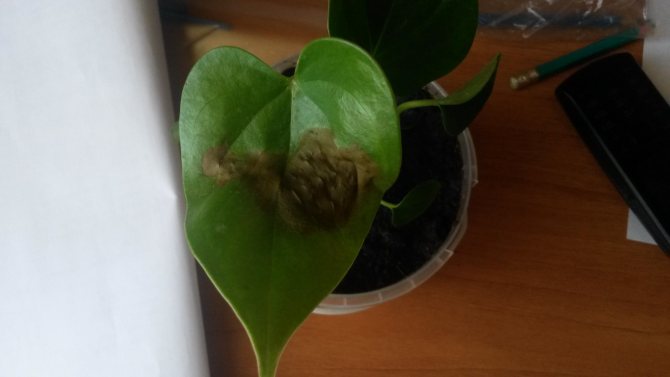

Draft sickness - Lack of lighting. It manifests itself as yellow leaves or spots of the same color.
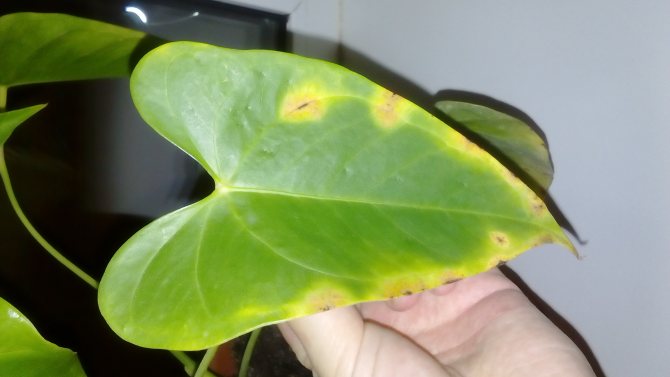

Yellowing of leaves - Lack of nutrients. Fertilizers are needed during the growth and flowering period. If there are not enough of them, it can interfere with flowering and the color of the leaves will become noticeably paler.
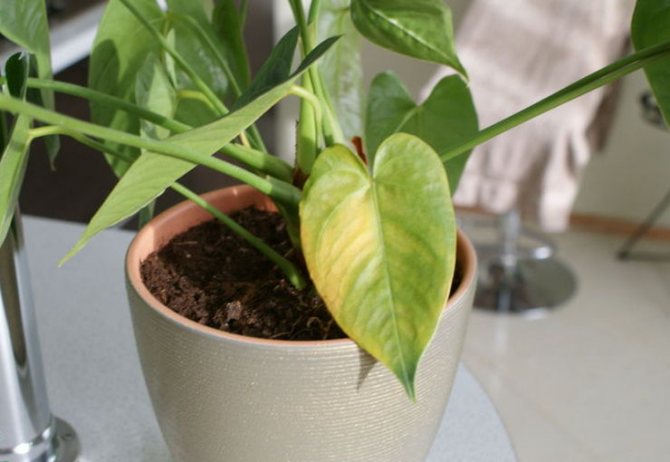

Lack of nutrients - Violation of the watering regime. Lack of moisture is just as harmful as excess.Both extremes will lead to the death of the indoor culture due to the death of the root system.
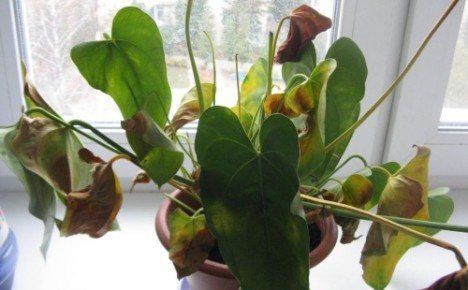

Violation of the irrigation regime
Pest infestation
Prolonged exposure to pests leads to the death of the flower, since the insect feeds on the sap of the plant and deprives it of the ability to maintain its own nutrition. Such infections are also dangerous because they can be transmitted to another green culture indoors. Regular inspection of all flowers will help identify and eliminate pests in the first stage of infestation.
Infection with such insects is common:
- Aphid. At the initial stage, you may notice that the leaves began to turn yellow and curl. When the defeat of aphids is already strong enough, a sticky bloom and a plant appear.


Aphid - Thrips. It is possible to suspect infection with this parasite by the small black dots on the back of the leaf, which are also accompanied by light yellow spots of various shapes.
- Spider mite. Usually, the onset of infection is missed, since it looks like small yellow dots, which gradually merge into foci and begin to deform the leaves. A tick is noticeable when it envelops the affected areas with a thin cobweb.
- Shield. At the initial stage of infection, the scale insect is not visible, later it can be identified by the white tubercles on the stem and leaves.
How to treat fungal and bacterial diseases of anthurium leaves
Anthurium treatment directly depends on the cause of the disease. First of all, you should check whether the flower is suffering from drafts or sudden changes in temperature, since this is the most common mistake in leaving. This can be an air conditioner, a fan, a balcony door that is constantly opening, or a slightly open window for ventilation in winter. If the cause is found, then there will be no re-yellowing. But the plant still needs to be reanimated.
If the leaves turn yellow in large quantities, then you need to do a transplant in order to examine the roots and change the soil, most likely, we are talking about an infectious lesion. Treatment is carried out according to the following algorithm:
- Remove all affected leaves with a sharp pruner, and treat healthy leaves with Epin - a stimulating drug.
- Gently remove the plant from the pot. To do this with minimal trauma to the roots, it is better to water the flower a couple of days before transplanting.
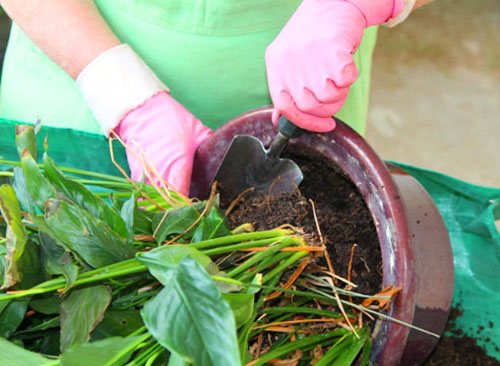

Transfer - Remove all soil from the roots and rinse with warm soft water.
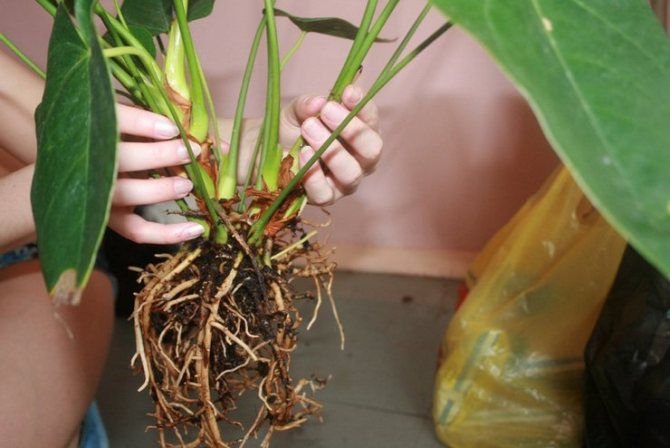

Root system cleaning - Inspect roots for rot, dryness, or lesions. Cut off all unhealthy areas with a sharp, sterile knife.
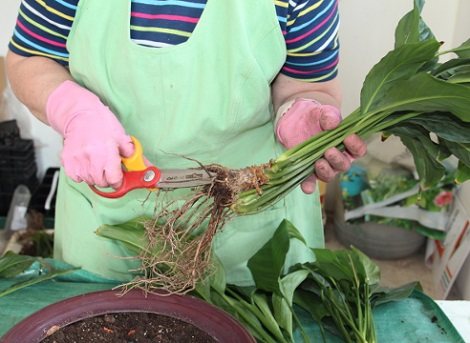

Root processing - Treat the roots with fungicides to prevent or treat fungal and bacterial infections.
- If after pruning there are no roots left, but there are still points of growth, then you need to wrap them with wet moss and put them in a transparent glass. Air for 15-20 minutes every day. Keep in a greenhouse with good humidity, under a phytolamp. When new roots appear, then go to step 7. If after pruning there are still living roots, then we skip point 6.
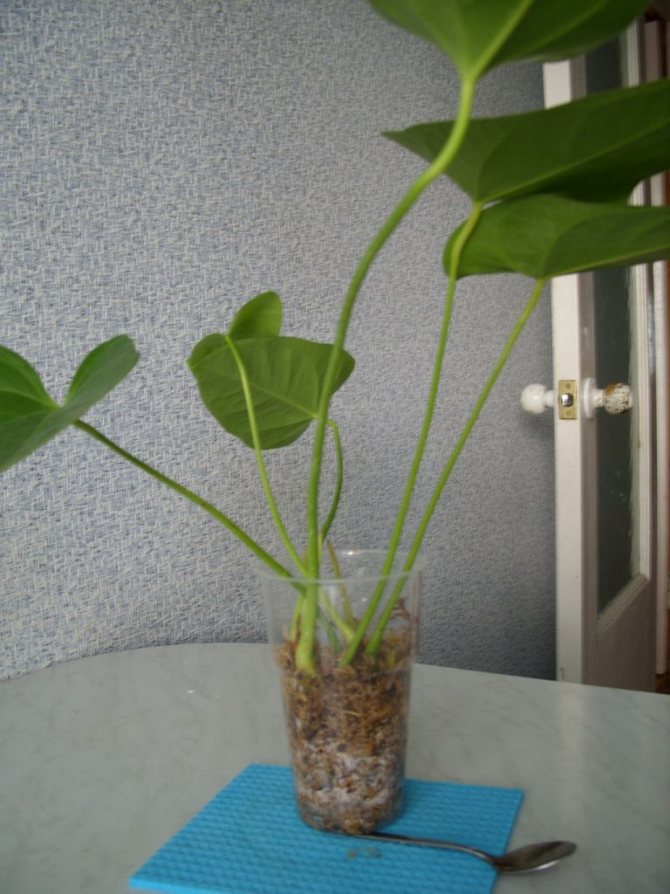

Germination of new roots - Prepare a new pot that needs to be adjusted to the size of the roots. They should not be cramped, but too spacious can destroy the plant, since all the forces will go into the growth of the roots.
- Fill the pot with drainage 30%. Next is a layer of soil. The soil should be taken for orchids, it is best suited for weakened anthurium.
- Plant a plant and fill the voids with earth.
- Care during the recovery period must be very careful, in compliance with all the necessary rules for keeping this species.
Lack or excess nutrition
If the anthurium stops growing abruptly, and its leaves dry up or turn yellow, this can happen due to a lack of nutrients. Lack or absence of phosphorus, potassium, nitrogen, magnesium and other elements will cause the plant to turn brown.
As top dressing, special ready-made products are used in a liquid state. Thanks to their effect, the diseased anthurium will restore a healthy and blooming appearance. You need to use these drugs weekly. As soon as the plant regains its former strength, mineral dressing is applied every 14 days.
However, not only a deficit, but also an overabundance of fertilizers can be the reason why the leaves of the anthurium dry. In this case, the root system must be rinsed in warm water and treated with a disinfectant, and then the plant must be transplanted into a pot with new soil.
Treatment for the defeat of anthurium leaves by pests
Treatment of Anthurium depends on what pests have affected it. The simplest treatment is for aphids. For this, the leaves are treated with chemical insecticides or folk remedies. Garlic infusion has proven itself well. To make it, half a glass of crushed garlic is poured with 5 liters of water and insisted for three days. Aphids cannot stand the smell of garlic.
The fight against spider mites is more difficult and is done according to the following algorithm:
- rinse the plant under a stream of warm filtered water to wash off cobwebs and parasites;
- treat the plant with acaricide and cover with a plastic bag for 3 hours;
- after 4 days, repeat the treatment;
- Treat once a week for 3 weeks, as young growth will appear.
To combat the scabbard, you must follow this plan:
- peel off scabbards from leaves and stems with a soft cloth;
- treat with Aktara chemical on the street or in a ventilated area, as the drug is toxic;
- in case of severe damage, alternate with Karbofos;
- transplant anthurium into new soil, removing the remnants of the old soil from the roots.
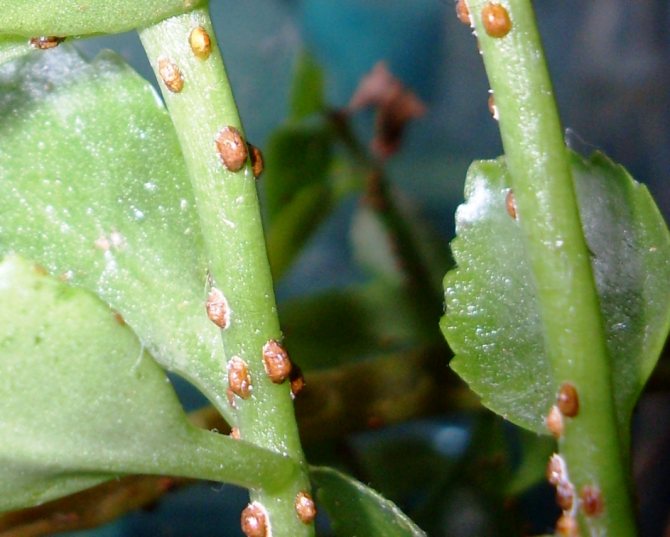

Shield
When a plant is damaged by thrips, it is necessary:
- remove all affected leaves;
- carefully remove the top layer of soil and replace it, as thrips eggs can be laid in it;
- treat the plant with chemicals;
- for a better effect, you can use a spray preparation (Aktara) and a soil irrigation preparation (Confidor);
- the procedure should be repeated 4 times at intervals of 7 days;
- for prevention, the plant can be watered with a decoction of celandine or yarrow.
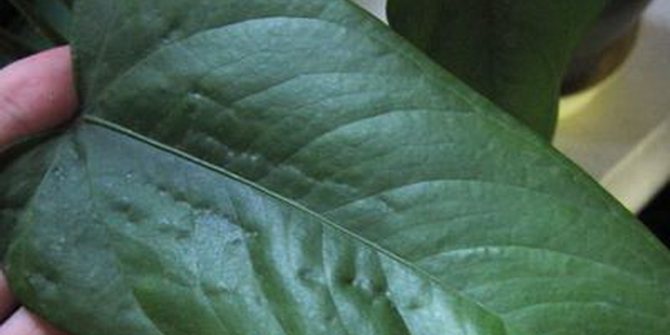

Anthurium leaf infected with thrips
When carrying out wellness procedures, it should be remembered that:
- at the time of treatment, the infected flower must be quarantined, separately from other indoor plants;
- all work with chemicals is carried out with gloves and in ventilated areas;
- Any flowers brought from a store or someone else's home must be quarantined for up to 2 weeks to make sure they are safe;
- the flower can easily become infected with pests again if the conditions of care are not followed along with the treatment.
Anthurium care video
Anthurium is a bright and unusual epiphyte native to the tropics. The plant is quite whimsical, but with some experience, patience and attention, you can grow a beautiful bush and wait for amazing flowers that will decorate your home. As a rule, anthurium is grown in greenhouses, but ideal conditions can also be created for it at home. The main thing is to know the main problems and fix them in time.
You can also share your secrets for caring for anthurium at home. If you have any questions - ask them in the comments below, we will be happy to answer them.
What to do to prevent leaf diseases
With severe lesions, treatment does not always help to save the flower, therefore, preventive measures are the best option:
- maintain the necessary humidity in the room using humidifiers, aquariums or other devices;
- hide the plant from direct sunlight and give a sufficient amount of diffused light;
- adjust watering so that the roots do not dry out and do not rot, always drain excess water from the pan;
- watering only with soft, settled water;
- when planting, provide a good drainage layer, which will also protect the roots from stagnant water;
- protect the pot from drafts and cold air;
- fertilize the soil regularly, but avoid oversupply.
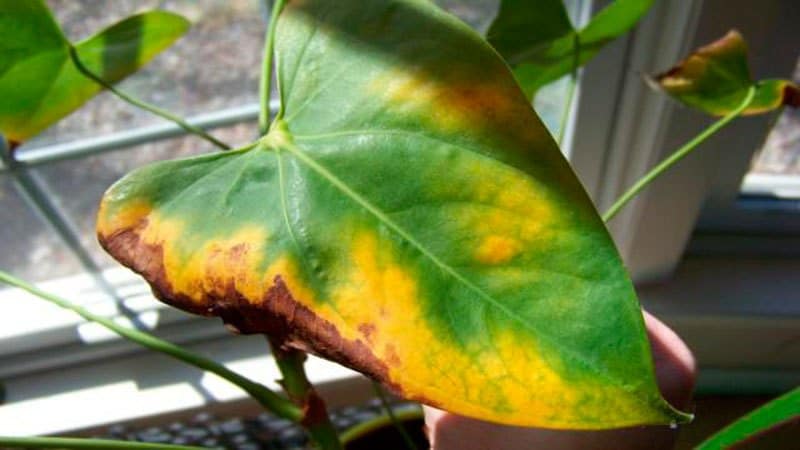

It will be more difficult to save anthurium from pests, because they can be brought into the house on clothes and shoes, with different colors.
But even in this case, there are preventive measures. Which will help reduce the risk of infection:
- keep all new plants in quarantine for 2 weeks;
- if the soil is suspicious, then it is better to change it;
- in spring and summer, leaf inspection should be carried out every week, in the cold season it is possible less often;
- once a month, you can carry out preventive treatment of leaves with soapy water;
- if there is a suspicion of infection, then it is better to immediately carry out the insecticide treatment, without waiting for active spread.
Dry air
This is a fairly common problem in centrally heated homes. If the tips of the leaves dry on anthurium, the plant may lack moisture, since it evaporates too quickly in a heated room. This happens more often when the flower stands on a wide windowsill, under which a heating radiator is installed. There are several ways to increase the humidity and improve the microclimate of the room for better growth of anthurium:
- Place the pot with the plant on a pallet with wet expanded clay or sphangum (another name is peat moss).
- Spray the leaves constantly with warm water so that drops do not fall on the inflorescences.
- Place a special humidifier next to the anthurium.
- Place a container of water near the battery or place a wet towel on top of it.
In any case, placing an anthurium near a heater is a bad idea. In addition, you should not water the plant often to increase the humidity in the room.

